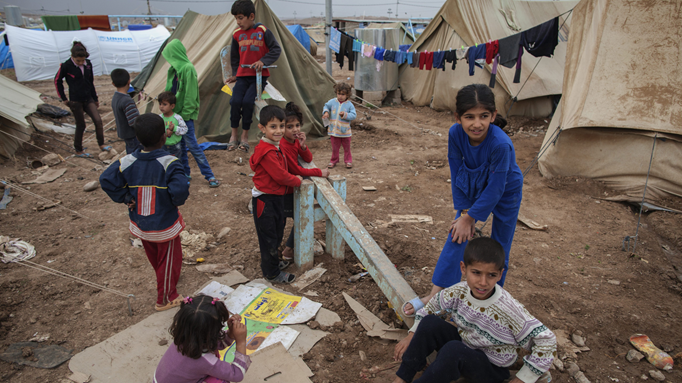Conflicting Area: How it Affect Children’s Psychological Condition
Children’s distress state can turn into a more dangerous mental disorder, such as post-traumatic stress disorder (PTSD).
Penulis Marsha Adzra Luthfia Ariananda28 Desember 2023
BandungBergerak.id – To live in this world means to settle in a place where it builds an environment, the one that is affected by human roles and is also affecting them. Different kinds of environments exist in this world, from the comfortable-ideal-like environment to the disastrous-conflicting-like environment.
Our psychological condition is one of the aspects that will be affected by the environment. The effects that environment brings may vary depending on how the situation is in that area and by the age of the human. Wessels (2016) said that children who were living in this area suffered from the ongoing cycles of violence, however the effects that it holds are differ according to their gender, culture, development stage, and other factors. That being said, children are put at greater risk when they live in a non-ideal environment (Bearer, 1995).
Mental State of Children Living in Conflicting Area
But how does it necessarily affect their psychological condition? With our common sense we know that living in conflicting areas will not do any good for our psychological condition. If we’re looking at the full scenery, this condition had a huge impact because of the conflicting environment rendering them high sites of unrelieved stress, the deprivation of access to basic needs, and the loss of social support that are critical for their well-being (Wessels, 2016). Family acts as a system that influences human’s characteristic and development because there are bonds between them (Hernández et al., 2023). In this case, children’s ability to adapt with stressful situations depends on how the condition in their family is, including the loss of emotional and social support (their family members) (Hernández et al., 2023). In general, the most common effects were enduring distress that were caused by the exposure to the conflict, such as violence traumatic distress and impaired parenting due to parental trauma (Miller & Rasmussen, 2017).
Children’s distress state can turn into a more dangerous mental disorder, such as post-traumatic stress disorder (PTSD). Children who have PTSD may have nightmares, flashbacks to traumatic events, aggressive behavior, and feel on alert all the time (Stanford Medicine Children's Health, n.d.).
Not only that, children with chronic PTSD if they don't get treatment may lead to functional disabilities (Zatzick et al., 2008). For example, data showing that 18% to 68.9% of children who were affected by the Israel-Palestine war are suffering from PTSD (Canetti et al., 2016). However, among Palestinian and Israeli children, the ones that have worse PTSD and depression are Palestinian. There needs to be further research regarding this, but the cause might be the prolonged exposure to the war (Canetti et al., 2016).
Baca Juga: Left Behind
Scattered Nazi Traces in Bandung
Seeing Football Through a Lens of Literary
Refugee Children
The environment plays a huge role in these aspects, children who are living in a conflicting area are either staying in the same place and witnessing the violence going through their whole life or displaced from their home, moving to another country and becoming a refugee. In 2014, there’s an outrageous conflict in Syria and more than half of the displaced were children (UNHCR, 2014). This is where the hardship comes, the sad fact about being a refugee is that there will be a lot of human rights violations, including discrimination from the host community, fears that are related to war, traumatic experience, and concern toward education (Hassan et al., 2016).
These violations resulting in their change of behavior, children are more vulnerable so they tend to isolate themselves and rarely go out in fear of receiving bad treatment. Being a refugee creates more problems for their psychological condition, one of the reasons is that they manifest negative emotions such as frustration, despair, and anxiety (Hassan et al., 2016). In another case, the forced displacement that was happening in Colombia caused children to have higher risk of depression, aggressive behavior, isolation, atypicality, hyperactivity, attention problems, and somatization (Hernández et al., 2023).
Cognitive Development of Children in Conflict Areas
As we mentioned before, children’s psychological conditions are prone to be more negative in responding to conflicting areas. However, this isn’t solely focused on their mental health, but also cognitive, behavioral, and emotional well being. One of the factors that are held accountable on the development stage are cognitive development, creativity of children who lived in conflict areas are in a concerning position, also compared to other children they’re less active and tend to be more silent (Ulfa et al., 2019). When the development stage is ruined by the exposure to violence, war, and forced displacement, it is negatively affecting their cognitive development (Hernández et al., 2023). Hernandez et al., (2023) proving in their research that children who have experience of living in conflicting areas have scores below the referenced average score in terms of working memory, phonological fluency, working memory, comprehensive language skills, and processing speed.
Conflicting areas have a huge effect on humans, but for children it will affect them a lot more as they are still growing up. Nonetheless it will bring more downside rather than the upside for children, the negative psychological condition that they suffer will have a bad impact on their daily life as it influences various aspects. Such aspects are cognitive skills, behavior, and mental health.


